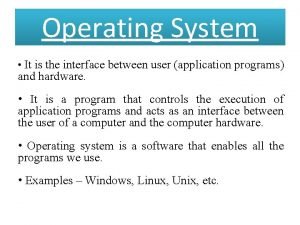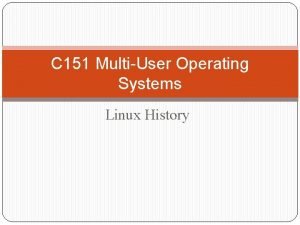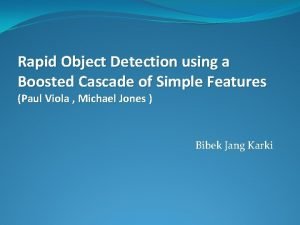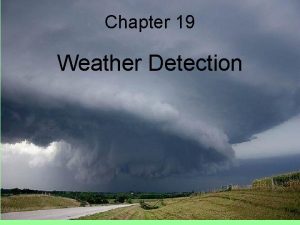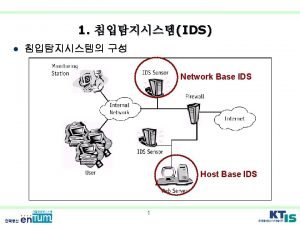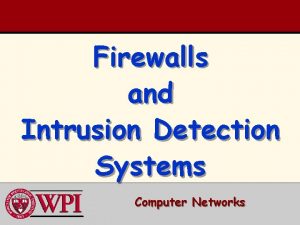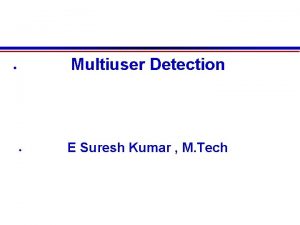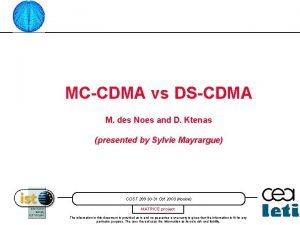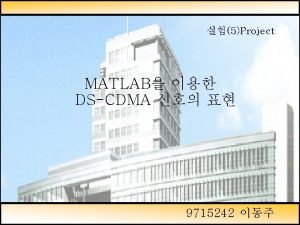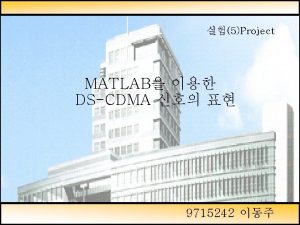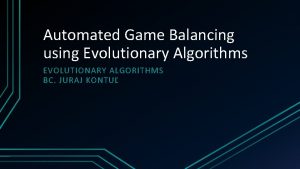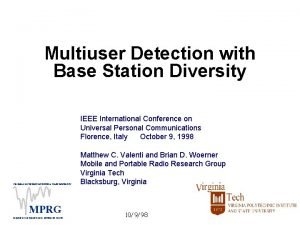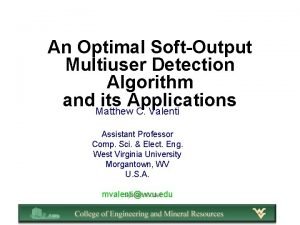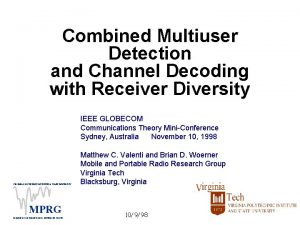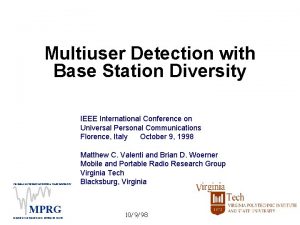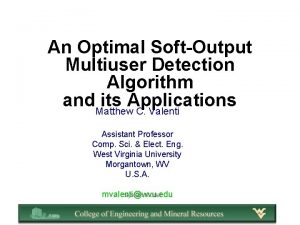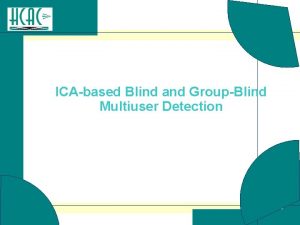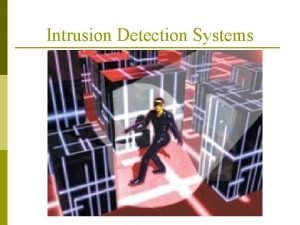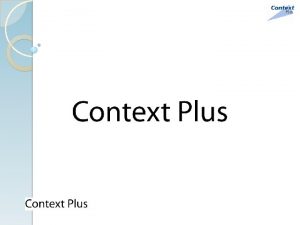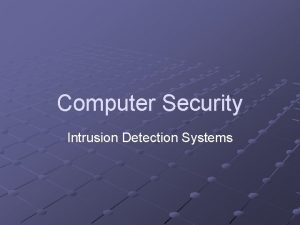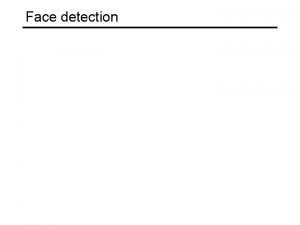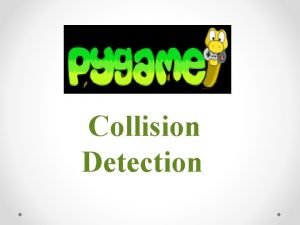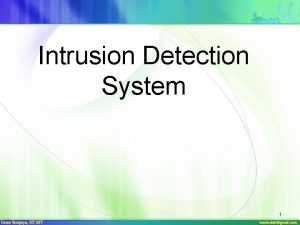Multiuser Detection for DSCDMA Systems Using Evolutionary TechniquesGA






















































- Slides: 54


Multiuser Detection for DS-CDMA Systems Using Evolutionary Techniques(GA & PSO ) Presented by Akram Rashid Department of Electrical Engineering Air University PAF Complex, Islamabad

Outline • • • Problem statement Multiple access schemes DS-CDMA systems Multiuser detectors (MUD) Multiuser Detection Evolutionary Techniques(GA, PSO) G A-MUD PSO-MUD How PSO performs Results

Problem Statement • In DS-CDMA signal is received and detected by a matched filters bank. This type of receiver is unable to detect the signal in optimum sence as channels are AWGN and the signal is not only effected by MAI but also by near-far effects resulting as decrease in channel capacity. One of the method to reduce these effects is to use all signal informations of all users in the detection process of desired users. This strategy is known as MUD.

Problem Statement(cont. ) • But in MUD • the computational complexity increase with the increase of number of users the system become unusable due to bit error rates increase • Many techniques have been proposed to remove these effects Evolutionary Techniques(GA & PSO) have also been used to solve these problems.

Multiple Access schemes • Multiple Access Techniques Multiple access techniques are involved when multiple users access the communication channel simultaneously. Basic Multiple Access Techniques are – FDMA – TDMA – CDMA – OFDM – SDMA

DS-CDMA Systems CDMA is based on spread spectrum techniques • CDMA has four major spreading schemes – TH-CDMA Here p-n code sequence defines the transmission moment – FH-CDMA Here p-n sequence defines the Instantaneous Transmission frequency - DS-CDMA Each user is assigned a unique code used as spreading sequence - Hybrid-CDMA DS-FH, DS-TH, FH-TH, DS-FH-TH, TDMA-CDMA

DS-CDMA System • Figure 1. 1 CDMA: three users share the same radio channel, but their signals can be separated because each user uses a different code

DS-CDMA System • : User signal and code are multiplied to generate the coded transmitted signal

CDMA Signal and Channel Model

Received Signal With BPSK modulation and synchronous channel shared by K users, the i-th bit of received baseband DS-CDMA signal is given by:

A typical CDMA Receiver

Multiuser Detectors • MF Detector(Matched filter detector) It is also called conventional detector or correlator. It maximizes the SNR for a particular user without accounting signals of other users. • Decorrelator Detector This detector maximizes the SNR while accounting the signals of the other users • ZF Detectr (Zero forcing detector) This correlator attempts to eliminate MAI in DS-CDMA without accounting AWGN • Interference Cancellation Techniques PIC & SIC

Multiuser Detectors(Conti) • MMSE (Minimum mean squared error)Detector MMSE linear MUD Performs better for all SNRs than ZF MUD as it accounts for AWGN. • MLSE(Maximum likelihood sequence estimator) A detector generates a maximum likelihood sequences in relation to the transmitted sequence • ML Detector (Maximum likelihood Detector) A detector that minimizes the error probability (for the case where the signals are equally likely

Multiuser Detection • Optimum MUD – Maximum Likelihood Detector Minimize

Multiuser Detection (contd. ) • Sub-Optimum MUD – Conventional MF detectpr – Second term is MAI • By assigning mutually orthogonal codes to all users, each of them may achieve interference free single-user performance. • But the orthogonal codes are limited. • Even by assigning orthogonal codes it is, however, not possible to maintain the orthogonality at the receiver in a mobile environment, and thus MAI appears

Multiuser Detection (contd. ) Decorrelating Detector • Disentangles the bits, • Require matrix inversion • Enhances noise

Multiuser Detection (contd. ) LMMSE Detector • Minimum mean square error detector seeks for the linear transformation • Where the matrix A is to be determined so as to minimize the mean square error Unlike the decorrelating detector, it requires the estimation of the users received signal amplitudes. Furthermore, like the decorrelating detector, the LMMSE detector also has to invoke matrix inversion. But it avoids noise enhancement

Multiuser Detection (contd. ) Interference Cancellation SIC There are so many variants of SIC and PIC

Evolutionary Techniques 1. EP(Evolutionary Programming) 2. GA (Genetic Algorithm) 3. PSO( Particle Swarm Optimization) -Less Detection time -Less computational cost and -Faster convergence

GA-MUD Start Y =0 Initialization • Fitness value evaluation Y=1 Decision Taken End Is TERMINATED? Create Mating Pool Uniform Crossover Binary Mutation Fitness Value Evaluation Elitism Y =Y+1

PSO- MUD • In ML Detector computational complexity increases with factor 2 raised power k • Complexity increase more rapidly if the number of users further increase, PSO is used to eliminate this problem • PSO, variants, These variants include the population size, initialization stage, Dimension size, Particle fitness, Velocity, local best position, global best position, Update in velocity, Update in particle fitness

The “inventors” (1) Russell Eberhart James Kennedy

PSO Flow chart

PSO-MUD(Cont. )

PSO-MUD(Cont. ) • Initialize a population of all particles in the swarm to random positions within the search space with binary strings. • Initialize velocities for each position in a particle for whole population. • Initialize particle personal best positions as the current positions of the particles. • Calculate the fitness for each particle by using a fitness function. • Initialize the global best position with the particle having the highest fitness.

PSO-MUD (Conti. ) • Repeat until convergence or maximum number of iterations – – Update the fitness of each particle using the fitness function and the current position of the particle. Update personal best position of each particle. Update the global best particle position. Update the velocity vector for each particle as follows • • where is the velocity of position of particle in iteration. is the mth position of ith particle. pim is the local best of ith particle and pgm is the global best particle. φ1 and φ2 are the weights for personal and global intelligence respectively.

PSO-MUD (Conti. ) Apply the bounds on velocity vectors as follows • where – • is constant representing the maximum velocity. Update each position of all the particles as follows where

PSO-MUD(Cont) • The number of particles in the initial population can be determined by :

How PSO works

Cooperation example

Psychosocial compromise y t i m i x o r i-p My best perf. pi Here I am! x pg v The best perf. of my neighbours y t i m i x o r p g

Initialization. Positions and velocities

Neighbourhoods geographical social

Animated illustration Global optimum

Adaptive swarm size There has been enough improvement although I'm the worst I'm the best but there has been not enough improvement I try to kill myself I try to generate a new particle

Adaptive coefficients av The better I am, the more I follow my own way rand(0…b)(p-x) The better is my best neighbour, the more I tend to go towards him

Results

My Contributions • The computational complexity of MLD grows exponentially with the number of users. • In addition to other techniques evolutionary techniques like GA and PSO has also been used to reduce the computational complexity of MLD. • Performance Comparison of MF Detector, Decorrelator, PIC, LMMSE, GA and PSO is made and best performance is analysed.

CDMA Baseband Signal

Walsh Spreading Codes

Received with AWGN S/N=2

Received with AWGN S/N=10

Transmitted vs Matched Filter Output

PARTICLES INITIAL POSITIONS • x= 4. 1374 3. 5776 2. 1907 3. 9862 3. 0053 0. 0212 3. 9956 3. 4024 4. 7664 1. 8107 0. 0293 2. 6307 2. 3135 2. 1683 0. 8134 3. 6419

PARTICLES INITIAL POSITIONS

PARTICLES INITIAL VELOCITIES • v= 0. 6715 0. 3310 0. 0871 0. 8048 0. 6843 0. 6779 0. 6916 0. 8092 0. 9062 0. 4556 0. 6410 0. 1387 0. 7593 0. 0523 0. 7004 0. 1553

Performance comparison of GA-based MUD and PSO-based MUD having computational complexity 200 for 10 user synchronous DSCDMA system

comparison of GA-based MUD and PSO-based MUD having computational complexity 600 for 20 user synchronous DS-CDMA system

Performance comparison of GA-based MUD and PSO-based MUD with different computational complexities for 20 user synchronous DSCDMA system

: Performance comparison of GA-based MUD and PSO-based MUD with other sub-optimal multiuser detection schemes for 20 user synchronous DS-CDMA system

: Computational complexity comparison of GA and PSObased MUD in order to find the optimum computational complexity

Conclusion • The Complexity issue of optimum OMLD has been addressed. – The main advantage of GA and PSO is their fast convergence – Both are Global Optimizers – Especially PSO algorithm gave very attractive results with very less number of computations as compared to MLD

 Which operating system is a multiuser os developed in 1969
Which operating system is a multiuser os developed in 1969 Xuml
Xuml Multiuser operating system
Multiuser operating system Rapid object detection using a boosted cascade
Rapid object detection using a boosted cascade Speed detection of moving vehicle using speed cameras
Speed detection of moving vehicle using speed cameras Weather detection systems
Weather detection systems L
L Firewalls and intrusion detection systems
Firewalls and intrusion detection systems Fiber perimeter intrusion detection systems
Fiber perimeter intrusion detection systems Iso 22301 utbildning
Iso 22301 utbildning Typiska drag för en novell
Typiska drag för en novell Nationell inriktning för artificiell intelligens
Nationell inriktning för artificiell intelligens Ekologiskt fotavtryck
Ekologiskt fotavtryck Varför kallas perioden 1918-1939 för mellankrigstiden?
Varför kallas perioden 1918-1939 för mellankrigstiden? En lathund för arbete med kontinuitetshantering
En lathund för arbete med kontinuitetshantering Underlag för särskild löneskatt på pensionskostnader
Underlag för särskild löneskatt på pensionskostnader Personlig tidbok för yrkesförare
Personlig tidbok för yrkesförare Sura för anatom
Sura för anatom Vad är densitet
Vad är densitet Datorkunskap för nybörjare
Datorkunskap för nybörjare Boverket ka
Boverket ka Debatt mall
Debatt mall Delegerande ledarstil
Delegerande ledarstil Nyckelkompetenser för livslångt lärande
Nyckelkompetenser för livslångt lärande Påbyggnader för flakfordon
Påbyggnader för flakfordon Vätsketryck formel
Vätsketryck formel Svenskt ramverk för digital samverkan
Svenskt ramverk för digital samverkan Jag har nigit för nymånens skära text
Jag har nigit för nymånens skära text Presentera för publik crossboss
Presentera för publik crossboss Jiddisch
Jiddisch Plats för toran ark
Plats för toran ark Klassificeringsstruktur för kommunala verksamheter
Klassificeringsstruktur för kommunala verksamheter Luftstrupen för medicinare
Luftstrupen för medicinare Bästa kameran för astrofoto
Bästa kameran för astrofoto Centrum för kunskap och säkerhet
Centrum för kunskap och säkerhet Programskede byggprocessen
Programskede byggprocessen Mat för idrottare
Mat för idrottare Verktyg för automatisering av utbetalningar
Verktyg för automatisering av utbetalningar Rutin för avvikelsehantering
Rutin för avvikelsehantering Smärtskolan kunskap för livet
Smärtskolan kunskap för livet Ministerstyre för och nackdelar
Ministerstyre för och nackdelar Tack för att ni har lyssnat
Tack för att ni har lyssnat Mall för referat
Mall för referat Redogör för vad psykologi är
Redogör för vad psykologi är Stål för stötfångarsystem
Stål för stötfångarsystem Tack för att ni har lyssnat
Tack för att ni har lyssnat Borra hål för knoppar
Borra hål för knoppar Vilken grundregel finns det för tronföljden i sverige?
Vilken grundregel finns det för tronföljden i sverige? Relativ standardavvikelse formel
Relativ standardavvikelse formel Tack för att ni har lyssnat
Tack för att ni har lyssnat Steg för steg rita
Steg för steg rita Ledningssystem för verksamhetsinformation
Ledningssystem för verksamhetsinformation Tobinskatten för och nackdelar
Tobinskatten för och nackdelar Toppslätskivling effekt
Toppslätskivling effekt Modell för handledningsprocess
Modell för handledningsprocess
